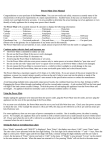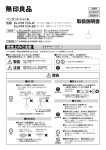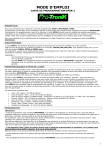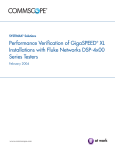Download POWER-MATE USER MANUAL CAUTIONS AGAINST ELECTRIC
Transcript
POWER-MATE USER MANUAL Congratulations on your purchase of the Power-Mate. It is now possible to determine the actual running cost of an appliance or even help to identify a faulty appliance that is using more power than it should. You can now easily and safely, measure accurately all the important power characteristics of a mains operated device. Another bonus is that you can finally have some control over your high electricity accounts. Please read this manual completely before using the unit. The Power-Mate will accurately measure & calculate to display the following information: (G-Gas is shorthand for greenhouse gas) Power: .…....…Watts/now……Watts/peak……Watts/min Voltage: ….……Volts/now……Volts/peak……Volts/min Current: ……......Amps/now……Amps/peak……Amps/min Energy: .…....….kWh/actual……kWh/hour……kWh/quarter….kWh/year Cost: …….......Cost/actual……Cost/hour…….Cost/quarter….Cost/year G-Gas: ….....…Gas actual….....Gas/hour……..Gas/quarter…..Gas/year Power Factor:.......PF/now Apparent Power:..VA/now Reactive Power:...VAR/now (Please refer to the glossary for an explanation of terms used in this manual) The Power-Mate does not use batteries; it uses a small amount of power (<1W) from the outlet it is plugged into. CAUTIONS AGAINST ELECTRIC SHOCK AND IMPROPER USE • The Power-Mate is intended for indoor use only. • Do not use the Power-Mate if the case or cord is damaged. • Do not use the Power-Mate if it becomes wet. • Avoid using the Power-Mate in bathrooms or wet areas. • Use the Power-Mate with sine-wave power sources only ie. mains power or inverters labeled as “pure sine wave”. • Do not use the unit with “Quasi sine wave” or square wave inverters, as the Power-Mate may be damaged. • Do not expose the Power-Mate to excessive heat ie. a vehicle in direct sunlight, to avoid damage to the case. • Do not dismantle the Power-Mate, there are no user serviceable parts inside and a shock hazard exists. • Return the Power-Mate to the manufacturer (or authorised agent) for repairs. The 10A, 10AHD and 10AHDS Power-Mates are limited to a maximum capacity of 10 Amps due to the rating of the Power-Plug. However the 10AHD and 10AHDS Power-Mates can easily measure inrush or start-up currents briefly up to 15A. The 15A Power-Mate is limited to a maximum capacity of 15 Amps of continuous current. If you are unsure of the power required for an appliance, a power (or current) rating is usually written on the unit’s label or even cast into the plastic or metal of the appliance. Alternatively refer to the appliance’s user manual in the specification section or contact the manufacturer. Avoid measuring multiple items using multi output power boards, unless sure the combined load is less than 10Amps (2.4kW). Damage to the Power-Mate through excessive overloading will not be covered under warranty. A red overload LED on the front panel will light brightly if the load current exceeds 10Amps. Contact the retailer or manufacturer if you have any specific queries regarding usage. USING THE POWER-MATE Simply unplug the appliance to be measured from the power outlet, plug the Power-Mate into the outlet, and now plug the appliance into the rear of the special plug. Now turn on the power point and clear the Power-Mate before starting a new measurement. For accurate cost calculation, the Power-Mate must be set to your local kilo-Watt-hour rate. Check your last power account to obtain the rate. If for example the amount is 18.5c per kWh, this may also be referred to as 18.5c per unit, this is a shorthand way of saying per kilo-Watthour unit. For some appliances, there are two types of power consumption to consider. One is standby power; the other is running power. For example, any appliance that can be turned on with a remote control uses a small amount of power whilst turned off. Power used when the unit is off is referred to as standby power and will usually be significantly smaller than the power consumed when the unit is turned on. POWER-MATE FUNCTIONS Each time the “Mode” key is pressed, the Power-Mate will advance to the next mode. The modes are Power, Cost, Energy, G-Gas, Volts and Amps (CUrr). Extra information is available in each mode by pressing one of the other 3 keys. When in Power, Volts or Amps modes, the Max. or Min. values since the test was started can be displayed, the Power Factor, Apparent Power and Reactive power values can also be displayed. In the Energy, Cost or G-Gas modes, hourly, quarterly or yearly values can be displayed. The last two modes are “CLEAr?” and “SEtUP?”. When Clear is selected, pressing the “Enter” key clears the totals for time, cost, energy and GGas. When Setup is selected, pressing the “Enter” key allows entry of the unit cost for energy (cents/kilo-Watt-hour), and the ratio of energy to G-Gas emission (enter and use 1.0kg per kWh if the exact value is unknown). Some appliances (such as mobile phone chargers) consume a very small amount of energy. In the Cost mode it could take many hours before even 1 cent has registered. When checking low power items, the Power-Mate’s display of cents to four digits is very useful and gives confidence that the Power-Mate is measuring. SETTING THE RATE OR GREENHOUSEGAS VALUES Press “Mode” repeatedly until “SEtUP?” is displayed. Press “Enter”, the display now shows “rAtE”, press “Enter” again. The edit LED will light green and the rate value is now presented with the first digit flashing. The first digit can be altered with the “+” and “–“ keys, when the digit is correct press “Enter” again and the next digit will flash, continue setting the digits similarly until the rate value is correct, the last press of “Enter” returns you back to “rAtE” in the menu. If “Mode” is now pressed, “G-Gas” can be entered in the same manner as the rate. When the menu has returned to G-Gas pressing “Mode” will exit back to the main menu. WHAT IS POWER, ENERGY ETC How do the power utilities charge you for their energy? Some of the terms used when discussing Energy are Volts, Amps and Power. Volts are a measure of the potential difference (PD) between two electric wires. This PD gives rise to the ability for current to flow if a load is connected between the two wires. Power is a direct result of the current that flows through the load and the PD that causes the current to flow. Energy is the amount of power that flows during a given time, the Power-Mate displays energy as kilo-Watt-hours, the same units used by electricity utility companies. The PD for Australian households is 230V AC, although it is commonly referred to using the older term of 240V. When the power utility produces Energy, a side effect is the production of Greenhouse Gases (G-Gas) which is mainly Carbon Dioxide (CO2). The ratio of Energy produced to the amount of CO2 gas created varies between different generator fuel sources ie Coal, Diesel or Natural Gas. If the ratio of Energy to G-Gas is entered into the Power-Mate, it can display the amount of G-Gas that is created by the energy use of an appliance. The value of greenhouse gas liberated per kilo-Watt-hour, for fossil-fuelled electricity generators is typically 1.0kg per 1kWh. The actual accurate most recent Greenhouse Gas yield per kilowatt hour can be obtained from the Australian Department of Climate Change, at the following web-site address: http://www.climatechange.gov.au in the NGA Factors document table #39. OTHER FEATURES OF THE POWER-MATE When in Volts or Amps (CUrr) mode, the Power-Mate will display the maximum and minimum voltages or currents recorded whilst in use. This information can be very useful for engineers and service technicians. The Voltage max and min feature can be used to determine the voltage stability from the power outlet; a load does not need to be connected for this purpose. The latest Power-Mate version retains its data after a power interruption. Please ensure to clear the unit before measuring something new. GLOSSARY Accumulated cost: Accumulated time: Hourly run cost: Quarterly run cost: Yearly run cost: Total running cost of the item, from when the test started. Time since the test was started. (Also called run time) Cost per Hour derived from total power for the total time. Cost per Quarter projection from average energy result. Cost per Year projection from average energy result. MENU FUNCTIONS Mode No Key Pressed “+” Pressed “–” Pressed “Enter” Pressed Power Power Max Power Min Power Power Factor Cost Actual Cost Yearly Cost Quarterly Cost Hourly Cost Energy Actual Energy Yearly Energy Quarterly Energy Hourly Energy G-Gas Actual G-Gas Yearly G-Gas Quarterly G-Gas Hourly G-Gas Hours HH : MM : SS Volts Volts Now Max Volts Min Volts Apparent Power Amps Amps Now Max Amps Min Amps Reactive power Clear? Enter clears data Setup? Enter for setup SPECIFICATIONS Item Range PM10A “PM10AHD (briefly), PM10AHDS (briefly) or PM15A (continuous)” Watts ± 0 – 2,500.00 W Cost & Cost Hr ± 0 – 99.9999 $ Cost Qtr, Yr ± 0 – 9999.99 $ Energy ± 0 – 999.999 kWh G-Gas ± 0 – 999.999 kg Run Time* 99Days 23 Hr, 59Min, 59Sec Volts 170.0 – 270.0V RMS Amps 00.000 – 10.000A RMS Power Factor ± 0.01 to 1 (leading/Lagging) Apparent Power 0 – 2,500.0 VA 0 – 3,600.0 VA Reactive Power ± 0 – 2,500.0 VAR ± 0 – 3,600.0 W ± 0 – 3,600.00 W 00.000 – 15.000A RMS Accuracy error for all ranges is better than 1%, (typical accuracy error is below 0.5%) Customer Care: 133 122 Fax: 1300 303 310 Internet: www.cabac.com, www.power-mate.com.au Email:[email protected]












